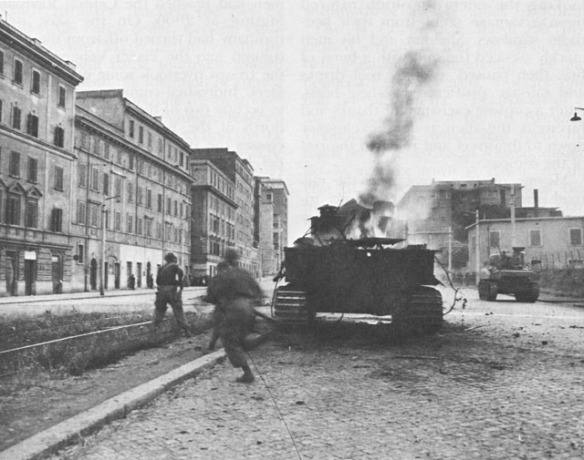
A TANK-INFANTRY TEAM entering Rome on 4 June. The burning vehicle is a German Tiger tank. The enemy had been evacuating the city for several days, but had left a strong rear guard equipped with tanks and artillery to hold the Allies in and below the city as long as possible. Since the streets of Rome were not suitable for conventional infantry attacks, small tank-infantry teams entered the city from several directions and by early morning of 5 June were in possession of the bridges across the Tiber.
One day of “Glory”. But by succumbing to the seduction of Rome, Clark had relinquished the momentum of the campaign.
Only with the fourth Battle of Cassino did Alexander and Clark achieve the level of coordination necessary to breach, at long last, the Gustav Line. This resulted in a general breakthrough and a massive offensive beginning on May 11, 1944. Monte Cassino fell, and the forces at Anzio could now commence their breakout as well. All elements were positioned for an attack on Kesselring’s forces at Valmontine. Here was an opportunity to destroy the principal part of the German army in Italy. But on the very verge of victory, Clark decided instead to capture Rome rather than concentrate on destroying the enemy army. It was an all too familiar temptation, especially given the historical and even mythic significance of the Eternal City and the fact that here was an opportunity to retake the first of the Axis capitals. Rome fell on June 4 (ironically, the landings at Normandy on June 6 stole Clark’s headlines as well as his thunder), but by diverting his forces to take Rome, Clark opened up a gap between the Allied armies and took the pressure off the rear of Kesselring’s forces. The Germans were therefore able to withdraw intact, their army preserved. Rome had been gained, but the chance to end the Italian Campaign swiftly had been lost.
The new Fourteenth Army commander could do little to reverse the tide of events. When units of the II and VI Corps began to exploit the gap made by the 36th Division, and when the FEC and Eighth Army renewed their attacks (north of Frosinone), Kesselring was forced on 2 June to order all German units to break off contact and withdraw north. Declaring Rome an open city on 3 June, the Tenth and Fourteenth Armies conducted an orderly retreat through the city. Only the suburbs were contested. On orders from Hitler, the wholesale vandalism and demolitions that had characterized the evacuation of Naples the previous fall were not repeated.
During the night of 4 June elements of the 1st Special Service Force, 1st Armored Division, and the 3d, 34th, 36th, 85th, and 88th Infantry Divisions entered Rome and quickly moved north. On the following morning large numbers of Romans poured into the streets to give the long columns of American soldiers still passing through Rome a tumultuous welcome. The American troops who actually liberated the city, however, had passed through Rome during the early morning hours in darkness and near silence and were again engaging the Germans along a twenty-mile front on the Tiber River.
The liberation of Rome made headlines around the world and was greeted by the Allies with great joy. Yet the capture of this first Axis capital had a high price. Since the start of DIADEM on 11 May, the Fifth Army had suffered a total of 17,931 American casualties: 3,145 killed, 13,704 wounded, and 1,082 missing 30 percent of the total casualties suffered by the Americans since Salerno in September 1943. French and British Fifth Army casualties numbered 10,635 and 3,355 respectively. The Eighth Army counted casualties of 11,639, bringing total Allied losses during the campaign to over 43,000. German losses were estimated at 38,000, for both Tenth and Fourteenth Armies, not including 15,606 prisoners of war.
There was little doubt now among the Allies that the Germans would be defeated in Italy, but by succumbing to the seduction of Rome, Clark had relinquished the momentum of the campaign. As far as the Allies were concerned, Italy was now very much a secondary front and six entire divisions were withdrawn from the country to participate in landings in the south of France. A plan to supplement the remaining U.S. and British forces with Italian troops enjoyed little success, and the continued Allied advance was greatly impeded by the many rivers that cross the Italian peninsula, especially after abnormally heavy autumn rains caused extensive flooding.